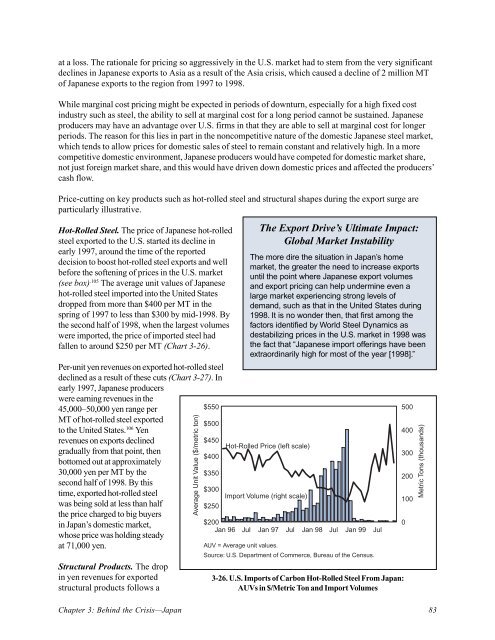Global Steel Trade; Structural Problems and Future Solutions
Global Steel Trade; Structural Problems and Future Solutions
Global Steel Trade; Structural Problems and Future Solutions
You also want an ePaper? Increase the reach of your titles
YUMPU automatically turns print PDFs into web optimized ePapers that Google loves.
at a loss. The rationale for pricing so aggressively in the U.S. market had to stem from the very significant<br />
declines in Japanese exports to Asia as a result of the Asia crisis, which caused a decline of 2 million MT<br />
of Japanese exports to the region from 1997 to 1998.<br />
While marginal cost pricing might be expected in periods of downturn, especially for a high fixed cost<br />
industry such as steel, the ability to sell at marginal cost for a long period cannot be sustained. Japanese<br />
producers may have an advantage over U.S. firms in that they are able to sell at marginal cost for longer<br />
periods. The reason for this lies in part in the noncompetitive nature of the domestic Japanese steel market,<br />
which tends to allow prices for domestic sales of steel to remain constant <strong>and</strong> relatively high. In a more<br />
competitive domestic environment, Japanese producers would have competed for domestic market share,<br />
not just foreign market share, <strong>and</strong> this would have driven down domestic prices <strong>and</strong> affected the producers’<br />
cash flow.<br />
Price-cutting on key products such as hot-rolled steel <strong>and</strong> structural shapes during the export surge are<br />
particularly illustrative.<br />
Hot-Rolled <strong>Steel</strong>. The price of Japanese hot-rolled<br />
steel exported to the U.S. started its decline in<br />
early 1997, around the time of the reported<br />
decision to boost hot-rolled steel exports <strong>and</strong> well<br />
before the softening of prices in the U.S. market<br />
(see box) .105 The average unit values of Japanese<br />
hot-rolled steel imported into the United States<br />
dropped from more than $400 per MT in the<br />
spring of 1997 to less than $300 by mid-1998. By<br />
the second half of 1998, when the largest volumes<br />
were imported, the price of imported steel had<br />
fallen to around $250 per MT (Chart 3-26).<br />
Per-unit yen revenues on exported hot-rolled steel<br />
declined as a result of these cuts (Chart 3-27). In<br />
early 1997, Japanese producers<br />
were earning revenues in the<br />
45,000–50,000 yen range per<br />
MT of hot-rolled steel exported<br />
to the United States. 106 Yen<br />
revenues on exports declined<br />
gradually from that point, then<br />
bottomed out at approximately<br />
30,000 yen per MT by the<br />
second half of 1998. By this<br />
time, exported hot-rolled steel<br />
was being sold at less than half<br />
the price charged to big buyers<br />
in Japan’s domestic market,<br />
whose price was holding steady<br />
at 71,000 yen.<br />
<strong>Structural</strong> Products. The drop<br />
in yen revenues for exported<br />
structural products follows a<br />
Average Unit Value ($/metric ton)<br />
$550<br />
$500<br />
$450<br />
$400<br />
$350<br />
$300<br />
$250<br />
Hot-Rolled Price (left scale)<br />
Import Volume (right scale)<br />
$200<br />
Jan 96 Jul Jan 97 Jul Jan 98 Jul Jan 99 Jul<br />
AUV = Average unit values.<br />
The Export Drive’s Ultimate Impact:<br />
<strong>Global</strong> Market Instability<br />
The more dire the situation in Japan’s home<br />
market, the greater the need to increase exports<br />
until the point where Japanese export volumes<br />
<strong>and</strong> export pricing can help undermine even a<br />
large market experiencing strong levels of<br />
dem<strong>and</strong>, such as that in the United States during<br />
1998. It is no wonder then, that first among the<br />
factors identified by World <strong>Steel</strong> Dynamics as<br />
destabilizing prices in the U.S. market in 1998 was<br />
the fact that “Japanese import offerings have been<br />
extraordinarily high for most of the year [1998].”<br />
Source: U.S. Department of Commerce, Bureau of the Census.<br />
3-26. U.S. Imports of Carbon Hot-Rolled <strong>Steel</strong> From Japan:<br />
AUVs in $/Metric Ton <strong>and</strong> Import Volumes<br />
Chapter 3: Behind the Crisis—Japan 83<br />
500<br />
400<br />
300<br />
200<br />
100<br />
0<br />
Metric Tons (thous<strong>and</strong>s)
















